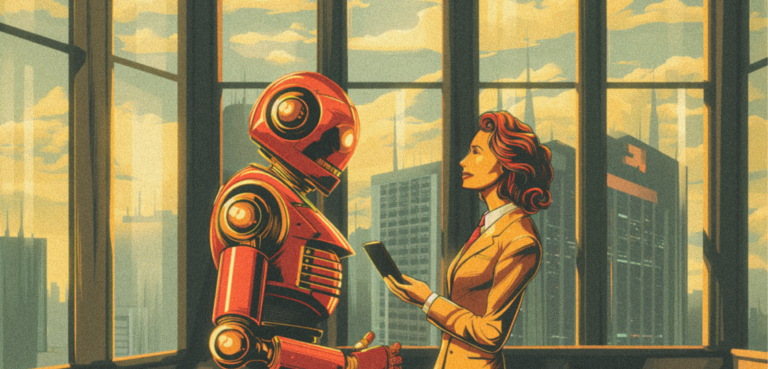Article

Industry 5.0: Offering Human-Centric Solutions
If Industry 3.0 is about generating data, then Industry 4.0 is about processing and analyzing it, while Industry 5.0 is all about intelligently using it with a focus on sustainability.
In this section, we present the concept of Industry 5.0, where machines are intertwined with humans to be able to work as collaborators instead of competitors. It will delve into the importance of Industry 5.0 and its principles, further setting the stage for businesses to understand and adapt to this new industrial era.
Industry 5.0 is going to grow like wildfire and spread across diverse industries due to the overwhelming demand for customized products and personalized experiences, growing emphasis on mitigating climate change, and the human-machine collaboration that empowers humans to work with advanced tools and technologies.
What is Industry 5.0?
If we take a step back to Industry 4.0, the entire market became more competitive, productive, and efficient. Driven by digitalization, Industry 4.0 helped organizations access, process, and share data at lightning speed. Now, we’re seeing 5.0 breakthrough the tech world to bring radical change to BizOps.
Industry 5.0 marks the synergy between humans and autonomous machines to facilitate continuous development and speed while focusing on increased personalization. This era aims to see automation of rote tasks to free up precious human time for tasks that require creativity, complex decision-making, and emotional skills. This is a remarkable shift from the advent of AI, ML, and RPA into a more holistic view where automation complements human skills and creativity in the workforce.
Industry 5.0 encompasses a wide range of technologies such as Cloud Computing, Artificial Intelligence and GenAI, Blockchain, Analytics of Big Data, Internet of Things (IoT), 6G Networks, etc.
Breaking down the three core values driving Industry 5.0
Industry 5.0 focuses on three interconnected core values: human-centricity, sustainability, and resilience.
1. Support, not supersede humans
At the core of Industry 5.0 is a central focus back to humanity while still leveraging the power of evolving tech. This era recognizes that machines will never overtake humans in the workplace but can work in coordination to streamline tasks and support automation and analysis where humans cannot.
2. Sustainability iniatives to protect the future
Echoing millennial and Gen Z commitment to reducing consumption, sustainability, and planet-saving measures, Industry 5.0 encourages adopting AI and smart machines to avoid resource depletion and environmental degradation. This evolution aims to align all business activities and processes around its effect on us and our planet. This era aims to move sustainability into a natural part of our corporate structure.
3. Resilience amidst global change
Industry 5.0 urges future industries to be resilient enough to swiftly navigate the geo-political shifts and natural emergencies. It focuses on being able to deal with uncertainty and change and being prepared to deal with vulnerabilities at all levels. It aims to make businesses more agile, adaptable, and flexible.
Looking toward the future of Industry 5.0: growth and implementation
The global Industry 5.0 market is expected to be valued at USD 65.8 billion in 2024 and is projected to reach $255.7 billion by 2029. It’s also expected to grow at a CAGR of 31% from 2024 to 2029. Convincing enough?
At the moment, many industrial behemoths and world leaders have started acknowledging the fact that this transition is the new leading light. Industry 5.0 is dominated by prominent key players such as ABB (Switzerland), Honeywell International Inc (US), 3D Systems (US), Rockwell Automation (US), Siemens (Germany) and Emerson Electric Co (US), among others.
In practical applications, the core tenants of Industry 5.0 are being deployed across all verticals:
- The agriculture industry is using various sensors for monitoring humidity, temperature, and soil moisture to better control and maintain the plants and trees in large-scale agricultural fields.
- The food industry has adopted IoT, Cloud, and AI in different stages including production, transport, storage, and consumption which has led to improved efficiency and productivity.
- The textile industry has incorporated cutting-edge technologies like robotics and automation in their operations to streamline their production processes, curtail supply chain costs, and create custom-made clothing on a larger scale.
- The Healthcare industry is working on advanced technologies like AI, blockchain, big data analytics, and robotics to produce personalized medicine, sophisticated diagnostics, telemedicine, and more patient-centric care.
- The aviation industry is widely embracing tech applications like big data analytics, machine learning, and IoT to offer a more ethical, immersive, and personalized travel experience to passengers.
Prepare yourself for the advent of Industry 5.0 by thinking big. Develop a strategic plan and start slow. Focus on innovation, agility, and speed. Leverage the expertise of established industry leaders. Then, think long term. Define the purpose of the change. Align the business priorities with the ethical ‘why we need to do it.” As we usher in a new era of technological advancement, start investing in products and training your people with skills development.
In brief
The transition from Industry 4.0 to Industry 5.0 promises to unlock new possibilities for businesses willing to embrace change. Expect more investment in sustainability, AI integration, and resilience amidst global change.